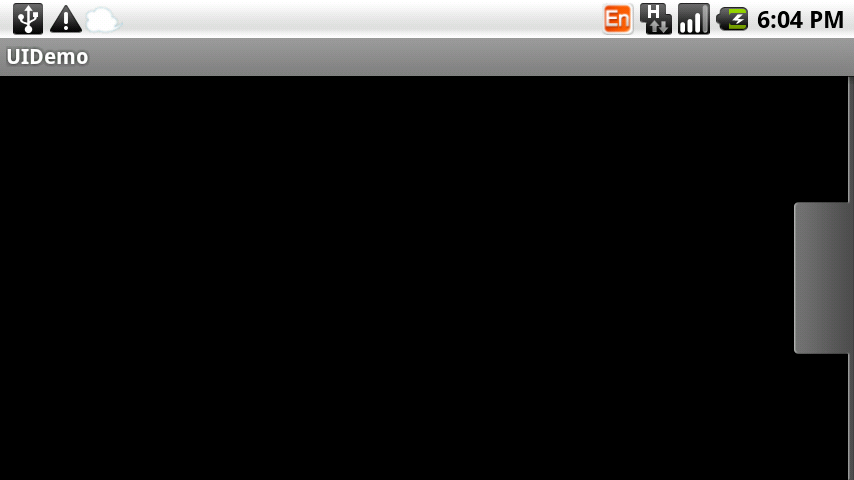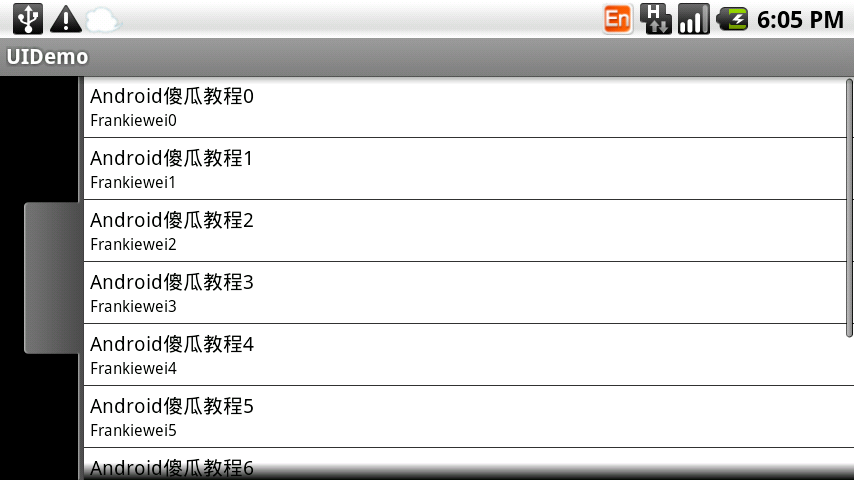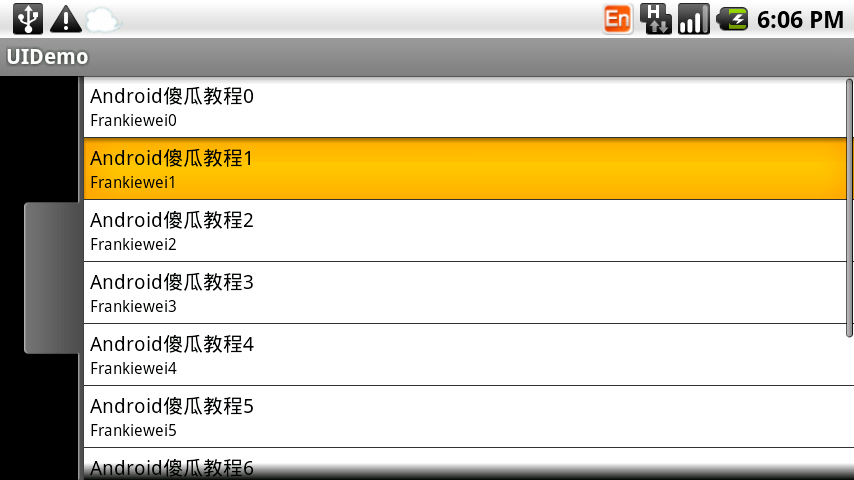Android 按钮的UI设计,ListView 以及GridView的UI设计
一.按钮的状态
我们一般搞UI设计,按钮通常有三个状态:normal(正常状态);focus(焦点状态),pressed(按下状态)。如下图所示:
我们会在res/drawable目录下定义一个资源文件,比如我们本例中要用到的handle.xml,在里面定义三种状态,每种状态对应一张图片。
代码如下:
 按钮Selector
按钮Selector
1 <?xml version="1.0" encoding="utf-8"?> 2 <selector xmlns:android="http://schemas.android.com/apk/res/android"> 3 <item android:state_window_focused="false" android:drawable="@drawable/handle_normal" /> 4 <item android:state_focused="true" android:drawable="@drawable/handle_focused" /> 5 <item android:state_pressed="true" android:drawable="@drawable/handle_pressed" /> 6 </selector>
而我们使用这个资源文件的用法只需要引用drawable里的资源文件(android:background="@drawable/handle")代码如下:
 View Code
View Code
1 <Button 2 android:id="@+id/handle" 3 android:layout_width="wrap_content" 4 android:layout_height="fill_parent" 5 android:background="@drawable/handle" 6 />
二.android的ListView,GridView UI设计
Android中的层:
看过《盗梦空间》的人都知道,梦境有多少层,而Android中也有层次之分,在Android中第一层"梦境",我们可以认为是壁纸。第二层就是 应用的Activity,第三层就是放在Activity上的容器(ViewGroup以及它的子类FrameLayout,LinearLayout等 布局对象),当然容器中还可以放容器,你也可以放到N层(最多放多少我还没验证过),总之最后一层就是那些继承于View的控件了(诸 如,Button,TextView等.)
而ListView以及GridView中UI是怎么设计的呢,下面我们看一下效果图:

上图是一个ListView的效果图,正常状态下是白色背景黑色字体,当我们点击一列时会出现黄色背景。这一效果是如何做到的呢?
ListView单元格显示的内容其实是我们事先定义在Layout目录下的一个布局文件,从这个效果来看,我们可以看出它一共有三个“层”
第一层容器(LinearLayout) 背景色为白色:
第二层也是容器(LinearLayout)当按下时,背景色为黄色,把第一层挡住(具体做法可以参照按钮):
第三层是控件(TextView)。
实例 :
上面说了一些,有些人肯定会云里雾里,所以我们直接来个实例,实例做完后,再看一下,效果会更好,大家按照步骤跟我来:
第一步:首先准备素材,准备三个按钮,以及ListView的背景图(上面三个按钮已经有了,下面我只贴一个ListView背景图片):
第二步:新建一个Android工程,命名为UIDemo.目录结构如下图所示:
第三步:在res目录下新建一个drawable文件夹,定义两个资源文件一个是handle.xml另一个为listview_selected.xml,其中handle.xml代码已经在上面贴出,listview_selected.xml代码如下:
 listview item selector
listview item selector
1 <?xml version="1.0" encoding="utf-8"?> 2 <selector xmlns:android="http://schemas.android.com/apk/res/android"> 3 <item android:state_pressed="true" android:drawable="@drawable/list_selector_background_pressed" /> 4 </selector>
第四步:修改main.xml布局文件,这里我用到了SliddingDrawer控件,代码如下:
 main布局
main布局
1 <?xml version="1.0" encoding="utf-8"?> 2 <LinearLayout xmlns:android="http://schemas.android.com/apk/res/android" 3 android:orientation="vertical" 4 android:layout_width="fill_parent" 5 android:layout_height="fill_parent" 6 > 7 <SlidingDrawer 8 android:id="@+id/slidingdrawer" 9 android:layout_width="fill_parent" 10 android:layout_height="fill_parent" 11 android:orientation="horizontal" 12 android:handle="@+id/handle" 13 android:content="@+id/content"> 14 <Button 15 android:id="@+id/handle" 16 android:layout_width="wrap_content" 17 android:layout_height="fill_parent" 18 android:background="@drawable/handle" 19 /> 20 <ListView 21 android:id="@+id/content" 22 android:layout_width="fill_parent" 23 android:layout_height="wrap_content" 24 /> 25 </SlidingDrawer> 26 </LinearLayout>
我们这里用到了ListView控件,而我们ListView控件显示的内容我事先在layout目录下定义两个TextView,命名为listview_layout.xml,代码如下(这里有三层哦!)
 listview item 布局
listview item 布局
1 <?xml version="1.0" encoding="utf-8"?> 2 <LinearLayout xmlns:android="http://schemas.android.com/apk/res/android" 3 android:orientation="vertical" 4 android:layout_width="fill_parent" 5 android:layout_height="fill_parent" 6 android:background="#ffffff" 7 > 8 <LinearLayout 9 android:orientation="vertical" 10 android:layout_width="fill_parent" 11 android:layout_height="fill_parent" 12 android:background="@drawable/listview_selected" 13 android:padding="6px" 14 > 15 <TextView 16 android:id="@+id/bookname" 17 android:layout_width="fill_parent" 18 android:layout_height="wrap_content" 19 android:textSize="20px" 20 android:textColor="#000000" 21 /> 22 <TextView 23 android:id="@+id/author" 24 android:layout_width="fill_parent" 25 android:layout_height="wrap_content" 26 android:textSize="16px" 27 android:textColor="#000000" 28 /> 29 </LinearLayout> 30 </LinearLayout>
第五步:修改主核心程序UIDemo.java,代码如下:
 核心代码
核心代码
1 package com.tutor.uidemo; 2 import android.app.Activity; 3 import android.os.Bundle; 4 import android.view.LayoutInflater; 5 import android.view.View; 6 import android.view.ViewGroup; 7 import android.widget.BaseAdapter; 8 import android.widget.ListView; 9 import android.widget.TextView; 10 public class UIDemo extends Activity { 11 12 private ListView mListView; 13 @Override 14 public void onCreate(Bundle savedInstanceState) { 15 super.onCreate(savedInstanceState); 16 setContentView(R.layout.main); 17 18 setupViews(); 19 } 20 21 private void setupViews(){ 22 mListView = (ListView)findViewById(R.id.content); 23 mListView.setAdapter(new ListViewAdapter()); 24 } 25 26 private class ListViewAdapter extends BaseAdapter{ 27 //这里返回10行,ListView有多少行取决于getCount()方法 28 public int getCount() { 29 return 10; 30 } 31 public Object getItem(int arg0) { 32 return null; 33 } 34 public long getItemId(int arg0) { 35 return 0; 36 } 37 public View getView(int position, View v, ViewGroup parent) { 38 39 final LayoutInflater inflater = LayoutInflater.from(getApplicationContext()); 40 41 if(v == null){ 42 v = inflater.inflate(R.layout.listview_layout, null); 43 } 44 TextView mBookName = (TextView)v.findViewById(R.id.bookname); 45 TextView mBookAuthor = (TextView)v.findViewById(R.id.author); 46 47 mBookName.setText("Android傻瓜教程" + position); 48 mBookAuthor.setText("Frankiewei" + position); 49 return v; 50 } 51 52 } 53 }
第六步:运行上述工程,查看效果:
运行效果1:
点击按钮效果2:
ListView正常效果3:
ListView点击效果4:









